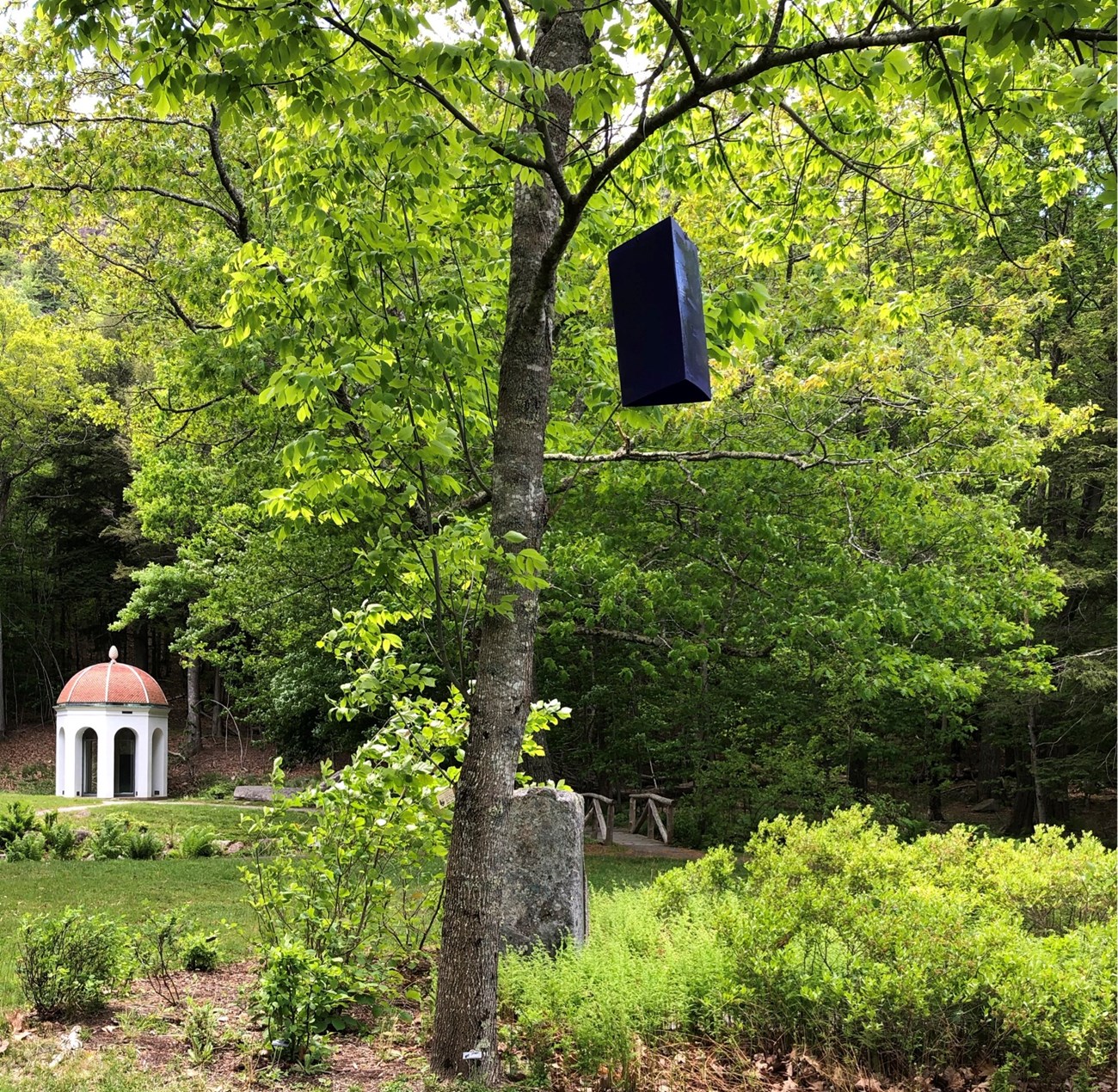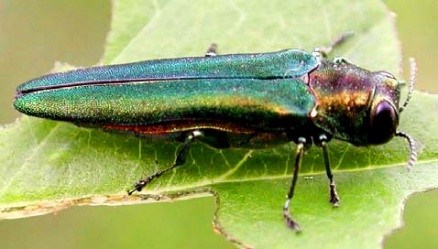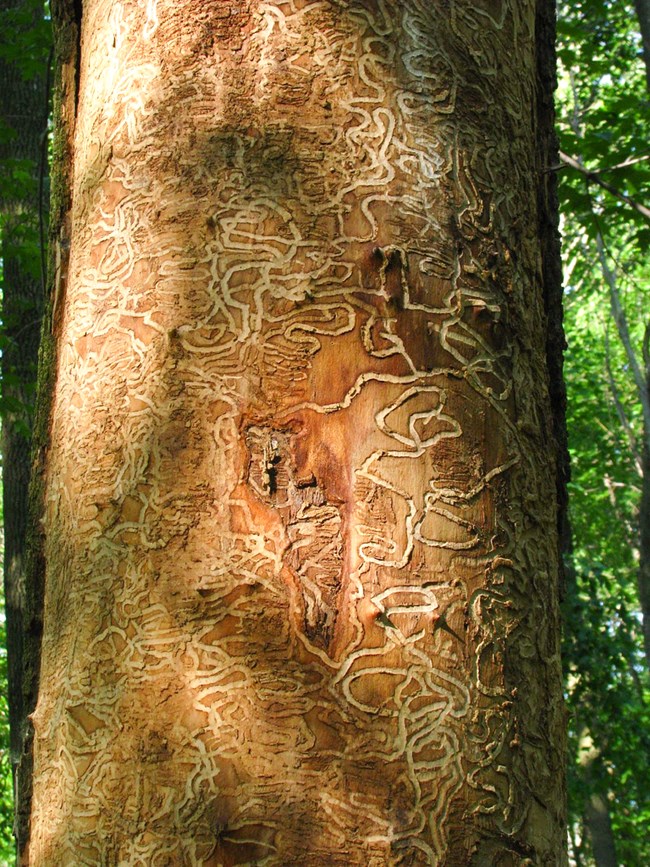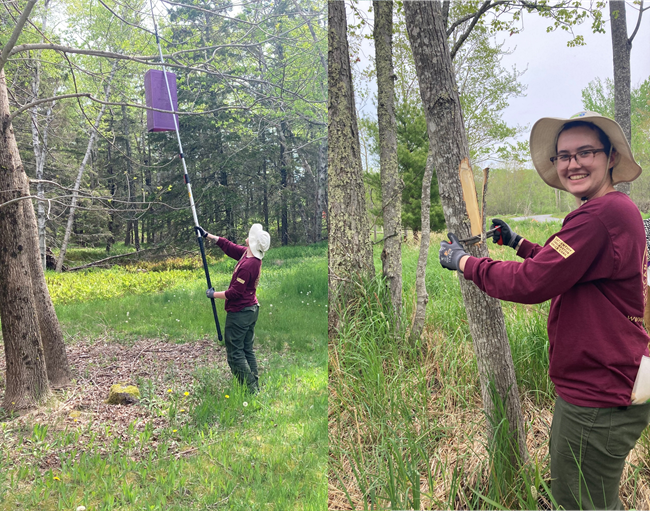Last updated: April 3, 2025
Article
Monitoring for Emerald Ash Borer in Acadia National Park

NPS/Acadia National Park.

USDA/Leah Bauer
Identification and Life Cycle
While EAB resembles other insects present in Maine, understanding its distinctive features and life cycle helps to distinguish it from lookalikes. Adult beetles are emerald green, under half an inch long, and active from June to August. During their three to six week lifespan, they mate and lay eggs in bark crevices.
While adults feed on ash leaves, it is the larvae that cause significant damage to the tree. EAB larvae bore through the host tree’s conductive tissue, preventing the flow of water and nutrients. The S-shaped tunnels, or galleries, formed by larvae essentially girdle the tree and can cause mortality within 3 to 5 years. Woodpeckers feed on the larvae and pupae, so bark loss, or blonding, from woodpecker activity is a common sign of EAB infestation. When the larvae develop and emerge as adults the following year, they leave characteristic D-shaped exit holes (about ⅛ of an inch wide) in the bark.

NPS/Rock Creek Park
What are the impacts of EAB?
The emerald ash borer causes mortality of all ash species present in Acadia National Park, including white ash (Fraxinus americana), the most common species, as well as green ash (F. pennsylvanica) and brown ash (F. nigra). Mountain ash (Sorbus americana), a small tree that resembles ash but is not closely related, is not a host species for EAB. Ash accounts for about 4% of the trees in Maine’s hardwood forests and 2% of all forest types. While some lingering ash trees remain in infested areas, EAB kills nearly 100% of ash trees once introduced. With over 17 million acres of forested land in Maine, the decline of less abundant species still represents a significant potential for loss.Ash is an important component of forests, riparian areas, and wetlands. Native ash species are a food resource for insects, birds, small mammals, and other wildlife. Loss of ash affects the soil composition and hydrology of wetland ecosystems. Rapid loss of any canopy species also provides an opportunity for invasive species to become established in new areas.
EAB affects all species of ash in North America, including those used in landscaped areas or as street trees. The Maine Forest Service estimates that the economic impact of EAB to forest landowners could be $320 million. Ash also has a unique significance here in the Dawnland, the homeland of four tribal nations known collectively as the Wabanaki. Ash is a cultural keystone species for Wabanaki peoples and essential to the tradition of basketmaking. Basketmakers specifically use brown ash, for which there is no substitute material.

NPS/Emma Lanning
Current Status and Monitoring
In March 2025, EAB was detected on Mount Desert Island outside the boundary of Acadia National Park. It was first reported in Maine in 2018. While EAB has been present in southern Maine and in Aroostook County for several years, this most recent detection shows how EAB can spread quickly over long distances. The Maine Forest Service quarantine area has since been updated to include all of Mount Desert Island.This order requires that all ash material remain within the quarantine zone on the island. EAB is primarily spread by moving infested wood products. In areas where it has been detected, any ash wood could be infested even if there are no visible signs. Take precautions to slow the spread of this and other invasive species, including purchasing and burning firewood locally and avoiding cutting ash trees or moving wood when EAB is most active. The highest risk of spread is from May 1st to October 1st.
Acadia’s Vegetation Program participates annually in a statewide monitoring network for EAB, which has not yet been found in the park. Resource managers install purple prism traps and girdle trap trees to attract adults during their active period. In the fall, trap trees are cut and logs are peeled to search for characteristic S-shaped galleries under the bark. As of 2024, EAB has not been found in the park using these methods. External signs and symptoms of EAB include woodpecker activity, bark loss, exit holes, and sprouting from the base of the trunk.
Report potential sightings to the Maine Forest Service and visit maine.gov/eab for more resources.
